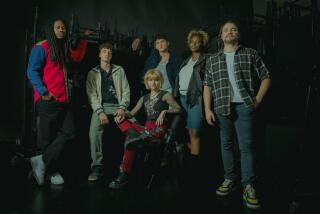‘See No Evil’? Deaf Film Actors Say They Do
- Share via
The summer smash comedy “See No Evil, Hear No Evil” isn’t drawing many laughs from members of the hearing-impaired community. They say the film just reinforces age-old stereotypes.
Tony Award-winning actress Phyllis Frelich said that the Gene Wilder-Richard Pryor comedy portrays deaf people with little dignity; she scornfully compared the film to one from the silent-movie era. She signed with a vengeance as she described this scene from an early ‘20s film:
A silent man on a busy sidewalk glares at a salesman while the salesman rambles on and on, trying to sell him a bottle of “miracle gel.” Finally, the silent man walks away. Behind him stands the Deaf and Dumb Institute.
“Gene Wilder is doing the same thing in ‘See No Evil, Hear No Evil,’ ” Frelich signed. “Being deaf and blind, they think those are funny handicaps. . . . It’s an inaccurate portrayal. They’ll do anything to sell a movie, at the price of making us suffer with the insults.”
In the movie, Wilder, as a deaf man, and Pryor, as a blind man, are co-workers at a Manhattan lobby newsstand. When a bullet-riddled corpse is left in front of their stand, they are swept up in non-stop adventure full of crazy gags and predicaments.
Frelich and others in the audience at a recent California State University Northridge seminar on the deaf in the film industry expressed their fury and frustration at Hollywood.
John Schuchman, a history professor at Gallaudet University, a college for the deaf in Washington, who led the discussion, said the ultimate breakthrough in the way deaf people are portrayed on film will be when more deaf people move behind the camera and do the producing, directing, writing and technical advising.
That has been done. A 1985 NBC-TV movie, “Love Is Never Silent,” which was co-produced by a deaf woman, Julianna Fjeld, and starred Frelich and deaf actor Ed Waterstreet, received an Emmy for best drama of the year.
However, a turning point for the entertainment industry in general, and the deaf community in particular, came in 1979, Schuchman said. That year Audree Norton, who is deaf, unsuccessfully sought the part of a deaf mother in the “ABC Afterschool Special: Mom and Dad Can’t Hear Me.”
The part was eventually given to a hearing actress, Rosanna Arquette, but the case became a focus of protest for deaf actors.
Schuchman said that before “Mom and Dad,” 33% of all deaf parts were played by deaf actors compared to 78% now.
Still, other issues for the deaf in films remain. Deaf actors, for example, don’t want always to be cast in movies with plots pertaining to their deafness.
“As a struggling actor,” said Bob Daniels, who is deaf, “I find that the worst problem is with producers who want ‘deaf stories.’ Why can’t a deaf person play the part of a taxi driver or a maid? It should be no big deal.”
He used as an example the recent CBS-TV movie “Bridge to Silence,” about a deaf mother, played by Marlee Matlin, who struggled for the custody of her daughter: “All the main characters in it were hearing. Where were all her deaf friends? Why do they always feature one deaf person, surrounded by hearing people?”
Frelich, who played the role of a Gallaudet actress in the film, said she was insulted with all the attention given the the fact that Matlin, who is hearing impaired, spoke in the film.
“Deaf people can speak,” she signed. “It’s not a big deal to us. It’s sad to measure a deaf person’s success and ability by the way they can imitate a hearing person.”
More to Read
The biggest entertainment stories
Get our big stories about Hollywood, film, television, music, arts, culture and more right in your inbox as soon as they publish.
You may occasionally receive promotional content from the Los Angeles Times.










